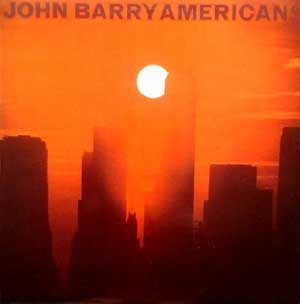Since then he has been in great demand by the film industry and in October, 1975 when to Los Angeles to spend five weeks working on a sound track. In fact his stay was extended and he was still there in August 1976, the bicentennial year when the United States erupted in a rash of firework displays, rocket landings on Mars and other carefully staged events to commemorate the Spirit of '76.
An initial (and continuing) interest in jazz plus an acute ear for th emost subtle nuances of harmony, rhythm and melody have all contributed to placing Barry in a commanding position to create musical tapestries. A month after arriving in Los Angeles the scores were ready and John was able to draw on the considerable talents available in the persons of outstanding musicians, many of whom came from jazz backgrounds. The extended "Yesternight Suite" is developed through a changing series of moods with the tensions building to logical climaxes, followed by equally logical releases into more relaxed climates. Dick Nash exposes the opening theme on trombone before the brass section builds up a riff. Using brass, woodwind and strings has enabled Barry to take advantage of a large palette of sound colors. The stings, for example, by their very nature are capable of producing quarter tones, a luxury denied many musical instruments without the use of false or unorthodox fingering. Under the expert leadership of the highly respected Israel Baker the strings produce all the correct textures from long-held single notes to throbbing, rhythmic figures. As part of John's picture of the United Sttes two well-loved melodies are introduced and woven into the overall tapestry. First Jerome Richardson's flute ushers in Arthur Schwartz's "By Myself" (from a 1938 Brodway show titled "Between the Devil") then, later, Barry uses the melody of "As Time Goes By." The latter is a popular song which he considers to be a classic of its genre: it actually dates from th 1931 revue "Everybody's Welcome" and was composed by Herman Hupfeld. Both songs are very typical of John's America and are separated by his "Yesternight Suite" by another typical American sound, the seductive, cosseting quality of an alto saxophone, played here by Ronnie Lang, whose work will be remembered principally from his days with Les Brown's orchestra. The excellent rhythm section displays its collective talents near the end, pivoting around the fulcrum of Mike Rubin's bass. A busy session man, Rubin made his first records with guitarist George Barnes (in 1946) and has worked with jazzmen such as Georgie Auld and Jack Teagarden.
The second side of the album comprises shorter pieces dedicated to more specific impressions. "Downtown Walker" is a casual stroll through the downtown streets by the young men-about-town. Here the principal stroller is Dick Nash, whose controlled trombone playing is masterly; like Ronnie Lang, Dick was a member of Les Brown's band for some yeras where he sat in the brass section behind his brother Ted, in the saxophone team. "Scorpio" positively dances along with John Guerin's drums always exactly in context. John Barry was born under the sign of Scorpio (on November 3, 1933, in that most beautiful and historic city of York) and it is intresting to read the predictions of a noted astrologer, Celeste, on Scorpio subjects: "they have enormous personal magnetism and they look at all the world through a microscope. They are great lvoers of the mysterious and of detective stories. The intense virility of this type often creates criminal lawyers and judges. They are endowed with boundless physical energy and can outstrip all otehr signs in sheer endurance." Although a number of outstanding saxophonists were born under this sign (notably Herb Geller, Zoot Sims, Phil Woods and Al Cohn), the tenor solo on "Scorpio" is played by a Capricorn. Jerome Richardson was born on Christmas Day, 1920, in Oakland, California. He returned to his native State after spending several years in New York where he worked with leaders such as gil Evans, Charlie Mingus, Oliver Nelson and Quincy Jones.
The stealthy and attractive "Social Swing" is, John thinks, more New York than Hollywood. "It's representative of the sophisticated society that many American enjoy today," he told me. Ronnie Lang's beautiful and Paul Demsond-like alto embellishes Barry's attractive melody, the stings providing a cushion behind the soloist. Dick Nash comes on sounding like Bill Harris from the classic Woody Herman Herd. "Strip Drive" is certainly West Coast rather than the Atlantic seaboard for John intended this to convey a drive along LA's Sunset Strip, a panoramic view of the places of entertainment. The excellent piano is the work of Arte Kane, a transplanted New Yorker now resident in Los Angeles, while Jerome Richardson's short but effective tenor solo brings to mind a whole era of jazz soloists from Sonny Rollins and John Coltrane downwards.
The final "Speaking Mirrors" was inspired by the big-city architecture of america with its towering buildings and reflecting glass set in curtain walls. The mood is suitably dramaic and the featured solo voice is the very precise and accurate trumpet of Tony Terran. John barry has turned the spotlght on a man whose name is often found tucked away in the personnels of studio assembled bands behind artists such as Lou Rawls or Benny Goodman, but on "Speaking Mirrors" Tony Terran proves that he is capable of interpreting John Barry's music to perfection.
Americans is a tribute to a country and its people by a musical writer of considerable skill and experience in the craft of juxtaposing visual and sound images. It is also further evidence that John Barry has the expertise not only to wright for films ranging from the Bond series to Eleanor & Franklin but also to create very personal vignettes employing the talents of some of the world's most accomplished musicians.

